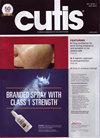杜匹单抗治疗类天疱疮妊娠。
IF 2.7
4区 医学
Q3 DERMATOLOGY
引用次数: 0
摘要
类天疱疮妊娠(PG)是一种罕见的自身免疫性大疱性疾病,推测是由过度的2型炎症免疫反应引起的。它表现为瘙痒性红斑丘疹或荨麻疹斑块,在妊娠中期或晚期进展为水泡性病变。临床和组织学上,PG类似于大疱性类天疱疮,并且同样与抗胶原跨膜蛋白BP180的IgG自身抗体的存在相关。Dupilumab是一种新型IgG4人单克隆抗体,可阻断IL-4Rα的信号传导,从而抑制Th2炎症反应。在这篇文章中,我们重点介绍了2例成功使用杜匹单抗治疗的PG患者。本文章由计算机程序翻译,如有差异,请以英文原文为准。
Dupilumab in the Treatment of Pemphigoid Gestationis.
Pemphigoid gestationis (PG) is a rare autoimmune bullous disease that is speculated to result from an excessive type 2 inflammatory immune response. It manifests as pruritic erythematous papules or urticarial plaques that progress to blistering lesions in the second or third trimester of pregnancy. Clinically and histologically, PG resembles bullous pemphigoid and is similarly associated with the presence of IgG autoantibodies against the collagenous transmembrane protein BP180. Dupilumab is a novel IgG4 human monoclonal antibody that blocks the signaling of IL-4Rα, which inhibits this Th2 inflammatory response. In this article, we highlight 2 patients with PG who were successfully treated with dupilumab.
求助全文
通过发布文献求助,成功后即可免费获取论文全文。
去求助
来源期刊

Cutis
医学-皮肤病学
CiteScore
1.10
自引率
0.00%
发文量
191
审稿时长
6-12 weeks
期刊介绍:
Published since 1965, Cutis is a peer-reviewed clinical journal for the dermatologist, allergist, and general practitioner. The journal is published monthly and focuses on concise clinical articles that present the practical side of dermatology. Referenced in Index Medicus/MEDLINE, it is respected and enjoyed by both specialists and derm-active generalists, enabling its readers to get what they need quickly and efficiently. Furthermore, Cutis is read by more physicians actively involved in the day-to-day treatment of dermatologic conditions than any other dermatology publication. Covering a broad range of pertinent and timely topics, Cutis is written and edited by industry leaders. For information on article submissions, please see our Information for Authors.
 求助内容:
求助内容: 应助结果提醒方式:
应助结果提醒方式:


